Science
Starliner Spacecraft's Landing on Sunday a Critical Moment for Boeing and NASA – Space.com
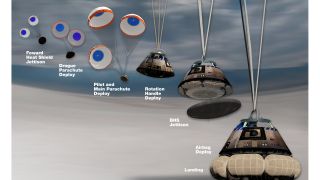

Update for Dec. 22: Boeing’s first Starliner spacecraft has successfully landed in New Mexico. For photos and videos, read our full landing story here.
Boeing’s first Starliner spacecraft will return to Earth Sunday (Dec. 22) to cap a rocky test flight that, despite some successes, left the capsule in the wrong orbit and unable to reach the International Space Station for NASA as planned.
If all goes according to the revised plan, the uncrewed Starliner — which Boeing designed to eventually fly astronauts for NASA — will land at White Sands Space Harbor in New Mexico at 7:57 a.m. EST (1257 GMT), six days earlier than its original Dec. 28 target. The spacecraft will rely on a heat shield to withstand the searing heat of reentry, three parachutes to slow its descent back to Earth and airbags to cushion its landing. And all of that gear needs to work perfectly for a safe touchdown.
“Tomorrow is a big day,” NASA Administrator Jim Bridenstine said of Starliner’s landing in a teleconference with reporters today (Dec. 21). “We have to be on our ‘A’ game.”
You can watch Boeing’s Starliner landing live on Space.com Sunday, courtesy of NASA TV, beginning at 6:45 a.m. EST (1145 GMT).
Video: How Boeing’s Starliner Spacecraft Will Land
More: Boeing’s 1st Starliner Flight Test in Photos
A critical test
“Entry, descent and landing is not for the faint of heart…”
Jim Chilton, Boeing Space & Launch Div.
A smooth, successful landing will be a redemption of sorts for Boeing’s Starliner, which was left in its unplanned orbit due to a timing error with the spacecraft’s mission clock. The glitch meant Starliner, which launched early Friday (Dec. 20), was unable to rendezvous with the space station to demonstrate its automated docking system, a vital capability for future astronaut missions.
But just as vital is landing safely. And that’s what Boeing will attempt to show on Sunday.
“Entry, descent and landing is not for the faint of heart, and this vehicle has not entered,” said Jim Chilton, senior vice president of Boeing’s Space and Launch Division. “We have not gone from space to the atmosphere.”
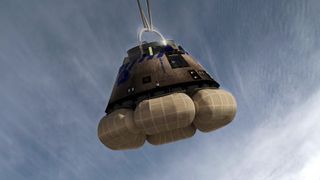
Leaving orbit
Starliner’s return to Earth will occur in stages, each of which must go right for the spacecraft to land safely. First, Starliner will have to leave its current orbit, which is about 155 miles (250 kilometers) above Earth.
To do that, Starliner’s service module will fire its thrusters in a so-called “deorbit burn” at 7:23 a.m. EST (1223 GMT) that will last 50 seconds. That should slow the spacecraft to about 25 times the speed of sound, Steve Stich, deputy manager of NASA’s Commercial Crew Program, said in the teleconference. Mach 25 is about 19,181 mph (20,870 km/h).
After the deorbit burn, the cylindrical service module should separate from the Starliner crew capsule and perform its own maneuver to fall safely out space and into the Pacific Ocean, Stich said.
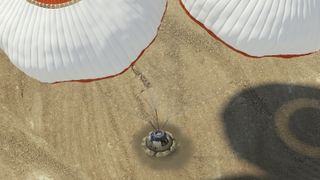
Parachute landing
The rest of the landing scenario relies on Starliner’s crew capsule, which will plunge through the atmosphere on a trajectory that flies over the Pacific Ocean and crosses Baja California and Mexico, and then just west of El Paso, Texas, to reach a landing zone at White Sands Space Harbor in New Mexico.
When the gumdrop-shaped Starliner slams into the Earth’s atmosphere, its heat shield will heat up to 3,000 degrees Fahrenheit (1,650 degrees Celsius), according to a Boeing mission description. The spacecraft will then jettison that heat shield and prepare to deploy its parachutes.
“By the time we get to 30,000 feet [9,100 meters], we’ll deploy parachutes; the vehicle will be going less than the speed of sound, less than Mach 1,” Stich said.
Starliner is equipped with three main parachutes to slow its descent back to Earth. During a pad abort test in November, only two of those parachutes deployed during a Starliner landing, a glitch Boeing pegged to a misaligned pin in the parachute rigging system.
Chilton said both Boeing and NASA have checked and double-checked that the pins in the current Starliner’s parachutes were installed correctly.
“We did have a NASA team go in and look at all the closeout photos,” Stitch added. “The parachutes on this spacecraft were rigged correctly.”
Starliner’s big test
At 3,000 feet (900 m), air bags should inflate on Starliner’s base. Those airbags are designed to cushion the impact of landing on astronauts inside the spacecraft.
While there are no human astronauts on this Starliner, the spacecraft is carrying “Rosie the Rocketeer,” a spacesuit-clad anthropomorphic test dummy equipped with sensors to measure what astronauts will feel.
“We’re going to be able to measure how the human would receive the Gs during entry, and also as the parachutes deploy and as we land,” Stich said. “We can measure that environment on Rosie and then extrapolate how a human would do in that environment.”
Related: Boeing’s CST-100 Starliner Space Capsule (Infographic)
After landing, teams from Boeing and NASA will arrive to recover the vehicle (and its Rosie dummy) to see how Starliner and its systems performed during the trip home.
About the only thing Starliner will not have done during its test flight is the actual docking with the space station. Timing issue aside, the spacecraft fared well during launch and its major systems performed as expected in orbit, Chilton said. Engineers were also able to to deploy and retract Starliner’s docking system to make sure it would work during actual dockings.
But just like launch, landing is a test that stands apart, Chilton said.
“Not all objectives are created equal,”he added. “Make no mistake. We still have something to prove here on entry tomorrow.”
Visit Space.com Sunday, Dec. 22, for complete coverage of Starliner’s OFT landing at White Sands Space Harbor, New Mexico.
Email Tariq Malik at tmalik@space.com or follow him @tariqjmalik. Follow us @Spacedotcom, Facebook and Instagram.

Science
Is space science worth the money? – The Planetary Society
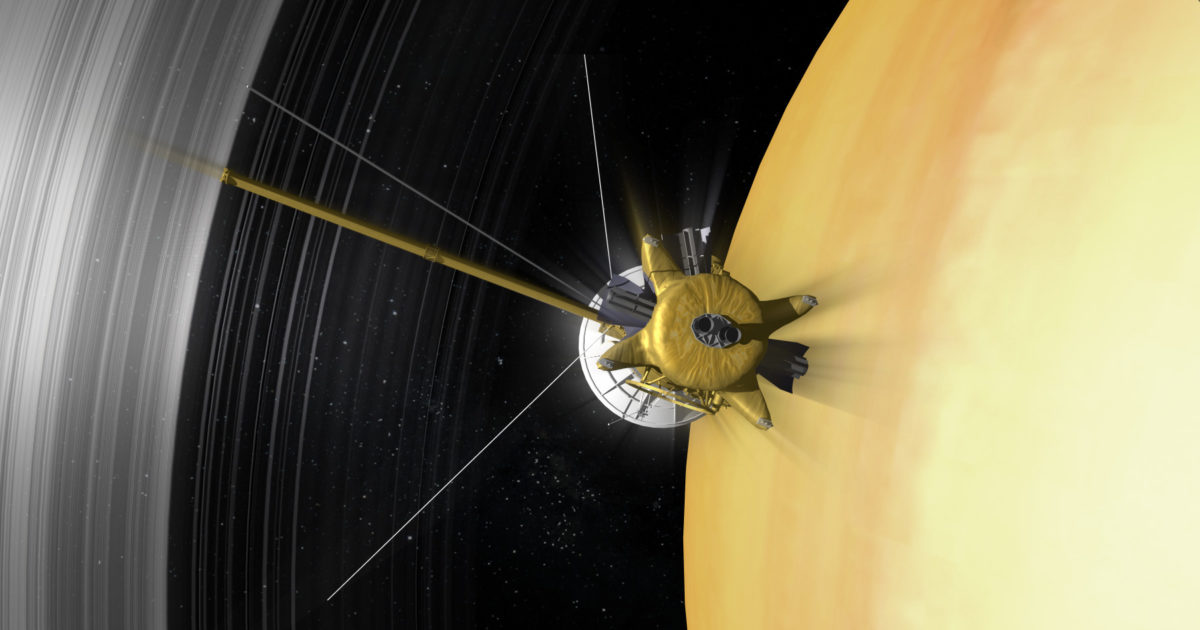

Why space science is worth the money
Although governments around the world understand the value of basic science, it can be hard to prioritize its funding given the variety of competing needs within a nation. NASA’s space science programs in 2024 amount to roughly 0.1% of annual U.S. spending, which represents a decrease in recent years. As such, space science sometimes needs to rely on justifications beyond its intrinsic value.
In a famous 2007 speech, former NASA Administrator Mike Griffin differentiated between the “real” and “acceptable” reasons for exploring space. “Acceptable” reasons for space exploration are logical, quantifiable, policy-friendly justifications. The “real” reasons, on the other hand, are intuitive, grand, emotional, and difficult to quantify. Both types of reasons are valid, and together they help explain why space science is worth the investment.
Some of the “acceptable” reasons for space science involve economic payoffs. Research has found that countries that invest more in basic research, including space science, see a return on investment in their overall economic performance and growth. This effect is dispersed throughout the economy through highly skilled, well-paying jobs. It also has an indirect effect on the economy: Discovery leads to technology and invention, which leads to new products, jobs, and industries. While technology development isn’t the primary goal of space science, this kind of progress would eventually stagnate if basic scientific research were neglected.
Another policy-friendly reason to invest in space science is that many scientific missions are internationally collaborative and contribute to allyship with other nations. There is also the very pragmatic goal of understanding Earth, the planet on which we all depend, by studying other planets and their histories. Venus, for example, was once an Earth-like world that eventually devolved into an inhospitable hellscape. By understanding that planet, we can work to prevent a similar fate for our own.
But, as Griffin explains, much of what humans do, from falling in love with one’s spouse to enjoying one genre of music more than another, is based on emotional and intuitive motivations. This is a human characteristic, and it plays out in our drive to understand the Universe and our place within it. In many ways, this is why we invest in space science: we want to go to new places and discover new things, witness the beauty and majesty of the Cosmos, understand where we came from and what might be possible in our future, and achieve astonishing feats.
Awe, wonder, and inspiration are among the “real” reasons for conducting space science. These are benefits that people can enjoy but that are impossible to quantify or justify on a budget balance sheet. Still, they are some of the most powerful motivators for studying the Universe and our place within it.
Science
Space exploration: A luxury or a necessity? – Phys.org


This article has been reviewed according to Science X’s
editorial process
and policies.
Editors have highlighted
the following attributes while ensuring the content’s credibility:
fact-checked
trusted source
written by researcher(s)
proofread
“Oh, come on Daniel, space travel is so expensive, and pointless!” These were the words of my friend Max, during a Christmas party where I was discussing my thesis project: studying places on Earth where the living conditions are so extreme, they could hold lessons for future space missions.
This disdainful attitude toward space research is actually quite common.
Space exploration is currently booming. Just think of the Artemis missions, SpaceX’s ambitious plans for Mars, the deployment of the James Webb telescope or the recent “race to the moon.”
A number of large-scale projects are getting the green light now, mainly from NASA, including the Artemis II mission that will carry four astronauts to the moon, which will have Canadian astronaut Jeremy Hansen aboard. This will be a first since 1972. Incredibly, it’s been 50 years since the last human mission to Earth’s natural satellite.
Although many people find space exploration inspiring, others are skeptical and even angered by what they see as an unjustifiable waste of resources and money on an activity that only spreads pollution to another place. This sums up the feelings of my friend Max.
In this article, I will try to prove him wrong.
Humans are explorers first
My great curiosity has led me to travel to extreme places so I can study them. But I am not the only one with this desire to explore.
In my Grade 9 history class, my teacher stood on top of her desk and, with a grave and serious tone, went on to act out Jacques Cartier’s arrival in North America in her own, colorful style. A few years earlier, I had learned about how the first humans left their caves to climb mountains. One hundred and thirty years ago, humans sailed further and further south until they saw the glacial landscapes of Antarctica for the first time. At the same time, humans were attempting to dominate the skies and aiming for the beyond with planes and rockets—which is how we got to the moon.
What is the common denominator in our history? Exploration, of course.
Human nature is characterized by a propensity to travel, to look further and to discover. We are all curious by nature. If we stop wanting to explore, we stop being human.
The Earth has rings
So, my friend Max, let me invite you outside. It’s a beautiful, starry night with no moon. It’s a bit cold, but at least the atmosphere isn’t too humid, which makes the sky more transparent. We can see stars flickering. Some are blue, others are red. And the more our eyes adapt, the more the sky reveals its secrets.
Suddenly, something else stands out. It’s another light, but it’s not flashing, and it’s moving quite quickly. A shooting star? No, the atmosphere would have burned it up in a few seconds.
It’s a satellite, one of thousands that orbit the Earth like rings. These satellites are a direct consequence of space exploration. We would be living in a completely different world without them.
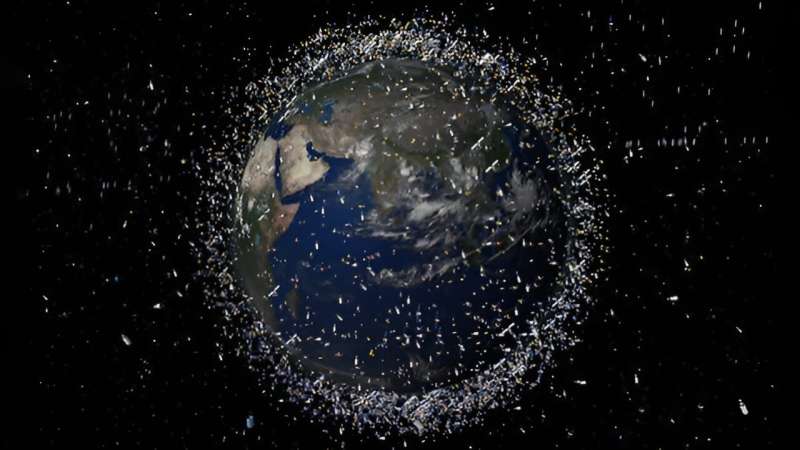

Indeed, not an hour goes by in our lives when we don’t use a satellite.
On the one hand, you would likely have gotten lost on your way here, Max, because there would have been no GPS to show you which exit to take. And secondly, I wouldn’t have been able to help you find your way because there would be no wifi. We can push our thinking even further; agriculture, environmental monitoring, communications, the weather, even banks, all of these depend on satellites.
But how does this work? You have to understand that these satellites move so quickly they actually circle the Earth several times a day. Combined with a very large workforce, they provide a complete view of the globe. From the middle of the oceans to the highest mountains and the almost inaccessible poles, we have eyes everywhere. By drawing on this vast quantity of observations, we obtain data on changes to the earth’s surface, the spread of forest fires, the movement of winds, the melting of ice and many other things, while enabling global communication and credit card transactions.
Space exploration was the trigger that enabled us to develop and operate these technologies. And it doesn’t stop there.
Two birds, one stone
The practice of medicine in remote areas also benefits from space exploration. It’s not easy for communities in remote areas to access health care, especially since hospitals don’t always have the sophisticated equipment they need.
If you think about it, when astronauts explore space, they become a small population in a very, very remote region. It’s true. What happens if someone has a really bad stomach ache? Or breaks an arm? They don’t have time to come back home for treatment, so we have to react, and quickly.
Scientific research in telemedicine has developed to address this important issue, producing a number of innovative technologies. And if these are useful for astronauts, why not use them for rural populations, too?
A few years ago, three Québec researchers from different universities were working on a tiny probe that could rapidly analyze and diagnose a blood sample.
Although some prototypes are not yet on the market, others are already in widespread use, such as the ultrasound scanner designed by NASA. This scanner takes precise photos of organs and bones that can be transmitted to a doctor, who will then have crucial information on hand to recommend treatments.
In a way, space exploration provides us with opportunities to respond to urgent needs on Earth. So, Max, are you beginning to see the need for it?
Another perspective
Finally, I have to admit that I find it rather encouraging to see Russians, Americans, Japanese, Canadians and Europeans living together on the Space Station. Not so long ago, some of these countries were attacking each other with nuclear bombs. In space, no such borders exist.
Exploration brings people together. It opens our eyes to new perspectives. It shows us that we’re all in the same boat together. That’s pretty important, don’t you think, Max?
Our planet is magnificent and unique, an oasis of impossible life. But it is fragile. We need to protect it. That’s why exploring beyond the Earth should not be considered a luxury; it’s an investment in our shared humanity.
So, Max, when Jeremy Hansen and his crew take off in 2025, will you be there to watch them?
Provided by
The Conversation
This article is republished from The Conversation under a Creative Commons license. Read the original article.![]()
![]()
Citation:
Space exploration: A luxury or a necessity? (2024, April 16)
retrieved 16 April 2024
from https://phys.org/news/2024-04-space-exploration-luxury-necessity.html
This document is subject to copyright. Apart from any fair dealing for the purpose of private study or research, no
part may be reproduced without the written permission. The content is provided for information purposes only.
Explore further
Through astronaut eyes, virtual reality propels gateway forward
Science
Mysterious object that hit Florida man's roof was part of the International Space Station – CBC News


When a strange object hit Alejandro Otero’s home in Florida, he had to return early from vacation. Once he got in touch with NASA, he learned it was a piece of space junk from the International Space Station.
The object was a piece of space junk that was expected to burn up in Earth’s atmosphere
NASA confirmed Monday that a mystery object that crashed through the roof of a Florida home last month was a chunk of space junk from equipment discarded at the International Space Station (ISS).
The cylindrical object that tore through the home in Naples on March 8 was subsequently taken to the Kennedy Space Center in Cape Canaveral for analysis.


The space agency said it was a metal support used to mount old batteries on a cargo pallet for disposal. The pallet was jettisoned from the space station in 2021, and the load was expected to eventually fully burn up on entry into Earth’s atmosphere, but one piece survived.
The chunk of metal weighed 0.7 kilograms and was 10 centimetres tall and roughly four centimetres wide.
Homeowner Alejandro Otero told television station WINK at the time that he was on vacation when his son told him what had happened.
Otero came home early to check on the house, finding the object had ripped through his ceiling and torn up the flooring.
“I was shaking. I was completely in disbelief. What are the chances of something landing on my house with such force to cause so much damage,” Otero said. “I’m super grateful that nobody got hurt.”


-
Media17 hours ago
Trump Media plunges amid plan to issue more shares. It's lost $7 billion in value since its peak. – CBS News
-



 Tech21 hours ago
Tech21 hours agoJava News Roundup: JobRunr 7.0, Introducing the Commonhaus Foundation, Payara Platform, Devnexus – InfoQ.com
-
Real eState21 hours ago
Real estate mogul concerned how Americans will deal with squatters: ‘Something really bad is going to happen’ – Fox Business
-



 Sports20 hours ago
Sports20 hours agoRafael Nadal confirms he’s ready for Barcelona: ‘I’m going to give my all’ – ATP Tour
-
Science21 hours ago
Total solar eclipse: Continent watches in wonder – Yahoo News Canada
-
Art24 hours ago
Art Bites: The Movement to Remove Renoir From Museums
-



 Investment18 hours ago
Investment18 hours agoLatest investment in private health care in P.E.I. raising concerns – CBC.ca
-



 Health23 hours ago
Health23 hours agoOpioid-related deaths between 2019 and 2021 across 9 Canadian provinces and territories





